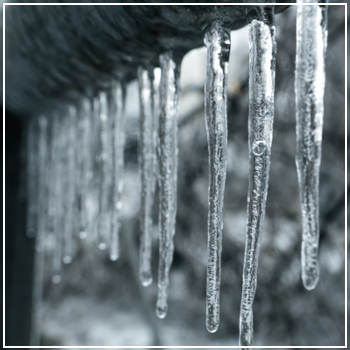What To Do If Your Pipes Freeze
 A sudden frost can quickly lead to frozen pipes. Yet, knowing what to do when this happens could be the difference between experiencing and avoiding a flood.
A sudden frost can quickly lead to frozen pipes. Yet, knowing what to do when this happens could be the difference between experiencing and avoiding a flood.
Why Do Pipes Freeze?
When temperatures dip, your home is at increased risk for experiencing frozen pipes. Before you see a large damp area on your floor, you might be dealing with a frozen pipe when you turn on the faucet and little or no water comes out.
Pipes that run through the foundation, along the exterior of your home or where utility lines enter have a higher risk of freezing. Common locations include the attic, crawl spaces, garage, kitchen cabinets, outdoor hoses and lines for a sprinkler or pool.
When water freezes, it expands. Inside a pipe, this can cause the material to crack. When a pipe bursts, the backed up water flows out through the opening into your home, where it can saturate floors, carpets, drywall and cause water damage and mold growth.
What To Do If You Suspect a Frozen Pipe
Once you notice water is not flowing through the pipes in your home:
- Turn off the water main to the pipe.
- Open any faucets connected to the pipe to release pressure buildup and lessen risks of a burst.
- Attempt to thaw any ice inside the pipe. Using a hairdryer or space heater is one common method, yet devices with an open flame should be avoided due to fire hazards.
Should a hairdryer or space heater not work, consider a stronger method like heat pads and cables. These can apply more warmth without increasing fire risks, however not every pipe can be thawed.
Those located within walls and other inaccessible spots require professional assistance. In these instances, plumbers use a thaw machine to apply low-voltage electricity through the pipe. This causes the ice to thaw and the warmed water to continue melting ice.
Even after water has started flowing through your pipes, the job is not over yet:
- Examine the pipe for leaks and cracks. Pressure may have distorted the material, leading to future leaks. Have a professional thoroughly inspect your plumbing system for this occurrence and any pipes that should be replaced.
- Inspect your home for water damage. Leaks may have caused water to pool in less-visible areas of your home, like the attic or behind a wall.
- After one pipe freezes, go through the rest of your home to check all faucets.
Long Term
In addition to insulating pipes located near the exterior of your home:
- Check the weather forecast. If below-freezing temperatures are predicted in your area, turn the faucet on so the water runs out in a light drip. Doing so can lessen the risk of freezing and release any pressure.
- Address issues that could be contributing to frozen pipes. In certain instances, they can be a sign your foundation has started to crack or crumble. As a result, pipes passing through the foundation are more likely to freeze. Consider having the pipes repaired and adding more exterior insulation.
Have you experienced a frozen pipe this season? Contact the plumbers at MJ Fahy & Sons to schedule an appointment to thaw the pipe, repair your plumbing or check the full system for damage. To learn more, contact us today.




